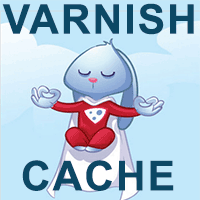 Varnish Cache is the best speed boost to give your WordPress site. Varnish is a reverse proxy that caches your WordPress site as HTML and serve them up quickly, bypassing the slow PHP backend (Apache or nginx). With this WordPress Varnish cache method you will always be serving up fast Varnish cached versions of your page.
Varnish Cache is the best speed boost to give your WordPress site. Varnish is a reverse proxy that caches your WordPress site as HTML and serve them up quickly, bypassing the slow PHP backend (Apache or nginx). With this WordPress Varnish cache method you will always be serving up fast Varnish cached versions of your page.
Varnish has a clever feature: using hash_always_miss lets Varnish continue to serve its cache version while it refreshes the cache from the PHP backend. This means you can slowly refill the Varnish cache instead of purging it all at once and being stuck with slow pages as new users request the uncached versions. I will assume you have access to your server (like with Digital Ocean) to install and edit files and have XML sitemaps enabled. Yoast SEO creates sitemaps for you and is what I use for this WordPress Varnish 4 Cache tutorial. To configure WordPress Varnish 4 cache see this tutorial.
I have a WordPress plugin which automates this, use the contact form to help test it and get a free copy
| VPS Provider | |||||
|---|---|---|---|---|---|
| Vultr | |||||
| Digital Ocean | |||||
| HostUS |
Warm up your WordPress Varnish 4 Cache Behind CloudFlare
I will assume you already have Varnish cache installed and configured to work with WordPress.
Check your Varnish version
varnishd -VIf it shows 4.x then this method will work for you behind CloudFlare, if you are on Varnish 3 then see my other tutorial.
Configure Varnish for Smart Refreshing and Real IP from CloudFlare
Open your Varnish vcl file, usually default.vcl
sudo nano /etc/varnish/default.vclAdd import std; at the top under vcl 4 to activate the std module which converts strings to IP addresses so you can match the real IP to your editors access control list you will create below.
vcl 4.0;
import std;Add an access control list (acl) section for editors, this is for security so that other machines cannot force refreshes on your page. Add it after the backend section but before the sub vcl_recv section. Change IP.of.Server to the source IP address that will be sending the refresh commands, I am just using the web server to run the script so it is the same IP as what CloudFlare points to for this domain.
acl editors {
"127.0.0.1";
"IP.of.Server";
}Adjust your VCL file to include always miss in your sub vcl_recv section, you only need to add the red section. It looks for the header Cache-Control with no-cache (which we will send later using curl) and whether the sender is a member of the editors acl. It uses the std.ip function in Varnish to get the real IP from CloudFlare and defaults to client.ip if it cannot detect the real IP. If you are using the DDoS protection guide, put this code before it so you ensure you get the right IP for the curl request to match in the editors acl.
sub vcl_recv {
# set realIP by trimming CloudFlare IP which will be used for various checks
set req.http.X-Actual-IP = regsub(req.http.X-Forwarded-For, "[, ].*$", "");
# check if the real IP is coming from your web server
if (std.ip(req.http.X-Actual-IP, "1.2.3.4") ~ editors) {
# if the header is set to no-cache set always miss
if (req.http.Cache-Control ~ "no-cache" ) {
set req.hash_always_miss = true;
}
}
}I have also set my Varnish time to live – how long Varnish should keep cached version of the page – to 1 year in the sub vcl_fetch function
set beresp.ttl = 52w;Test your adjusted Varnish default.vcl works
varnishd -C -f /etc/varnish/default.vclIf you didn't get any errors reload your Varnish configuration
sudo service varnish reloadManual Varnish Smart Refresh for Single URL
Create a new script that will send the always miss request for a URL you paste into the script when prompted
nano smartvarnishrefreshsingle.shPaste this code
#!/usr/bin/env bash
# WordPress Varnish Cache Refresh from HTPCGuides.com
echo Enter full URL to purge
read url
curl -s $url -H "Cache-Control: no-cache" -o /dev/null
echo Refreshed $urlCtrl+X, Y and Enter to save the script
Make the script executable
sudo chmod +x smartvarnishrefreshsingle.shRun the manual single Varnish purge script like this
bash smartvarnishrefreshsingle.shYou will see this output, just paste your URL and press Enter
Enter full URL to purgeNow that page has been intelligently refreshed using Varnish
Refresh Entire WordPress Varnish Cache Automated Method
The automated slow Varnish cache refresher script requires xml2 and curl so install them
sudo apt-get install xml2 curl -yCreate the varnishsmartrefresh script
nano varnishsmartrefresh.shPaste this, adjust site to your site's name
#!/usr/bin/env bash
site=https://www.htpcguides.com
#Download post sitemap
wget -q $site/post-sitemap.xml -O postsitemap.xml
#Parse the xml file and put it into posts.txt
xml2 < postsitemap.xml | grep /url/loc= | sed 's/.*=//' > posts.txt
# Loop through the posts.txt and use curl to send an always miss request
while read post; do
curl -s $post -H "Cache-Control: no-cache" -o /dev/null
echo Refreshed $post
echo Waiting
sleep 10
done < posts.txt
#Download page sitemap
wget -q $site/page-sitemap.xml -O pagesitemap.xml
#Parse the xml file and put it into pages.txt
xml2 < pagesitemap.xml | grep /url/loc= | sed 's/.*=//' > pages.txt
# Loop through the pages.txt and use curl to send an always miss request
while read page; do
curl -s $page -H "Cache-Control: no-cache" -o /dev/null
echo Refreshed $page
echo Waiting
sleep 10
done < pages.txt
#Download category sitemap
wget -q $site/category-sitemap.xml -O categorysitemap.xml
#Parse the xml file and put it into categories.txt
xml2 < categorysitemap.xml | grep /url/loc= | sed 's/.*=//' > categories.txt
# Loop through the categories.txt and use curl to send an always miss request
while read category; do
curl -s $category -H "Cache-Control: no-cache" -o /dev/null
echo Refreshed $category
echo Waiting
sleep 30
done < categories.txt
# Warm up and refresh blogroll pages, change 30 to the number of pages back you show posts
for i in {1..30}
do
echo Refreshing $site/page/$i
curl -s $site/page/$i/ -H "Cache-Control: no-cache" -o /dev/null
echo Refreshed $site/page/$i
echo Waiting
sleep 1
done
Ctrl+X, Y and Enter to save the script
Make the script executable
sudo chmod +x smartvarnishrefresh.shRun the Varnish cache refresh script to test it
bash varnishmartrefresh.shYou will see a lot of curl commands and Refreshed URL names, this will take a while depending on how many posts, pages and categories you have.
I have also added a daily cronjob for refreshing the WordPress Varnish Cache
crontab -l | { cat; echo "@daily /path/to/varnishslowrefresh.sh"; } | crontab -Manual WordPress Varnish Refresh Method
Go to your sitemaps, you can use as many or as few as you want
- Posts – http://www.yourwebsite.com/post-sitemap.xml
- Pages – http://www.yourwebsite.com/page-sitemap.xml
- Categories – http://www.yourwebsite.com/post-category.xml
Highlight and copy the entire table to the clipboard
Go into Excel or any spreadsheet program and paste it
Do a search or find and replace, make find your full URL http://www.yourwebsite.com and leave the replace blank
Highlight the whole column and copy it to the clipboard, you will paste it in the manual script below
sudo nano smartvarnishrefresh.shChange your site name and paste your WordPress URLs from the spreadsheet to refresh in the Varnish cache (adapted from here)
#!/usr/bin/env bash
site="https://www.htpcguides.com"
pages="
/
# Paste your URL sitemap here
/100-amazon-gift-card-giveaway-july-2015/
/40-amazon-gift-card-giveaway/
"
echo -----------------------------
echo Refresh old pages from cache
echo -----------------------------
for page in $pages; do
echo Setting always miss for $site$page
curl -s $site$page -H "Cache-Control: no-cache" -o /dev/null
sleep 10
done
Ctrl+X, Y and Enter to save the script
Make the script executable
sudo chmod +x smartvarnishrefresh.shRun the manual Varnish cache script
bash slowvarnishpurge.shThese WordPress Varnish Cache scripts should ensure you are always serving content quickly to your site's visitors even if you are behind CloudFlare.
